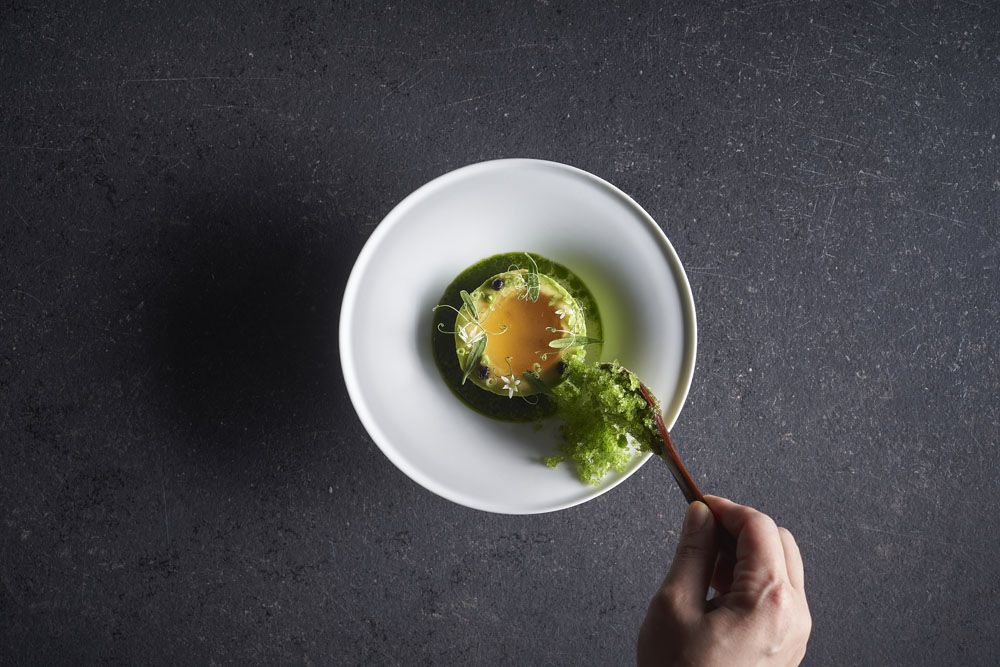The Filipina chef, who is the recipient of the Asia's Best Female Chef Award 2023, reflects on her kitchen journeys—from leaving her job at Procter & Gamble to heading a stalwart restaurant in Singapore
Female chefs are a dime a dozen, but few relish the same extensive influence and ceaseless admiration as Lolla head chef Johanne Siy, who has received plenty of acclaim for her savoir-faire in the kitchen. Nightly, the Filipino native doles out her speciality dishes like the lightly grilled giant Spanish carabinero prawn served with prawn jus to an adoring audience, hungry for her prodigious creations. And according to the Dagupan-born chef, this dish is one that best encapsulates her culinary philosophy. “We take a top-notch ingredient that we carefully sourced, cook it simply and don’t fuss around with it too much—but serve it with elements that look simple but are in fact painstakingly made with a lot of effort and love. It is mindful, respectful of nature and understated in presentation but big on flavour.”
Meals hardly come with a thesis statement, but at Lolla, one cannot dine without first appreciating Siy’s ideologies. At the heart of their cuisine, is the concept of sustainability: a mindset that transcends beyond just food. Even chipped dishes are never thrown out—the industrious chef repairs them herself. And while 2021 wasn’t the best year for an industry that had been heavily upended by the pandemic, it was by all accounts, still a marvellous year for Siy. The year reached a thundering crescendo when she captured the coveted title of female Chef of the Year during Singapore’s World Gourmet Awards. Certainly, the chef and her team have done something quite revolutionary with Lolla, and they hope to leave a legacy for future generations. Could Lolla one day grace Michelin’s glittering hall of fame? For Siy, anything is possible.

During your four years at Singapore’s Restaurant André, what were the most important things you learned that shaped your culinary philosophy today?
Johanne Siy (JS): When we start out doing something, be it as simple as creating a dish or a bigger undertaking like opening a restaurant, we usually start out with intentions that are pure and personal. Along the way, we get influenced by so many things, and more often than not, we lose focus. When this happens it’s always helpful to go back to the end in mind.
You also had stints in New York's Le Bernardin and Cafe Boulud, Sweden’s Faviken and Copenhagen’s Noma and Relae. What were some of the key takeaways?
JS: Le Bernardin is an amazing three-star restaurant that does about 300 covers in one day. They can do this because they have the 80/20 rule down pat. They know what they are about—outstanding seafood and they focus on that. The fish is always the star of the plate. Everything else is secondary. At Café Boulud, I learned that if we ever hope to even come close to being good in this industry, we should never stop learning.
During my time at Noma, I understood the importance of thinking out of the box and the value of specialisation. In most restaurants, every cook goes through the same hierarchy. You work your way up the line to a management role. But some people have more to give. Some are passionate about fermentation, for example, and are really good at it. You have to recognise this and give them an opportunity to showcase their skills and lead with their passion. At Relae, I learned the value of context. When I was there, I got the chance to work in the farm and harvest the vegetables to be used for service every day and this gave me a lot of respect and appreciation for farmers and producers. Seeing the whole process until it makes it to the plate makes you appreciate it more. Finally, at Faviken, I was taught that necessity is the mother of invention and scarcity encourages innovation. In the coldest months, nothing grows so what do you serve your guests? Frost from the trees? Fallen leaves? They do that—who would have thought? When your options are whittled down, you get creative with what you have.
In case you missed it: These Asian tastemakers are behind the best dining experiences in the region



